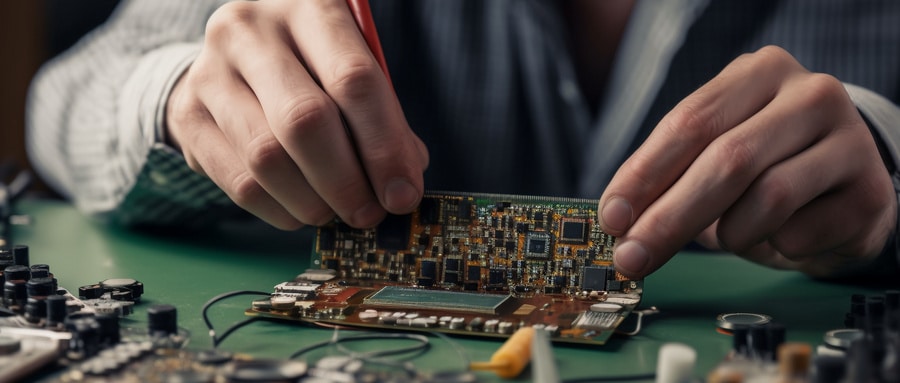Riding the Wave of Innovation: An Insightful Exploration into Polyimide PCBs
Electronic engineers often face the challenging task of creating smaller electronic devices without compromising performance or reliability, which is where Polyimide PCBs, an often-overlooked material in electronics industry, play an essential role in furthering technological progress. This revolutionary material has proven essential in furthering technological progress.
Understanding The Basics: What Is a Polyimide PCB?
Polyimide PCBs are Printed Circuit Boards (PCBs) made with polyimides, an esteemed class of polymers known for their outstanding thermostability and mechanical properties. Polyimide PCBs’ superior heat resistance combined with their flexibility makes them popular choices in numerous demanding environments; furthermore, “flex” in “flex pcb” doesn’t just refer to physical flexibility but also to adaptability and versatility brought about by these boards.
Recognizing The Remarkable Features
Polyimide PCBs stand out from other materials due to their impressive array of properties. From their superior temperature resistance and dimensional stability, to strong mechanical strength and excellent chemical resistance, all of which contribute to prolonging electronic device lifespan significantly.
Polyimide’s Diverse Applications
Polyimide PCBs find use across numerous fields: aerospace, automotive electronics, medical devices and even high-end consumer electronics all reap the rewards from Polyimide’s unique set of advantages.
Polyimide has long been used in aerospace applications due to its extreme durability under high temperatures and vibrations, making it suitable for spacecraft and satellites. Due to its minimal outgassing properties, polyimide also makes for ideal packaging material.
With the rise of electric vehicles (EVs) and autonomous driving comes an increasing need for tough and durable components in automotive electronics. Polyimide PCBs with their ability to withstand even extreme environments are an ideal solution to meet this demand.
Medical applications of high flexibility semiconductors include pacemakers and defibrillators; their adaptable nature enables these devices to adapt to body movements while still ensuring long-term performance.
Exploring Manufacturing Options
Polyimide PCB manufacturing involves several complex steps, from circuit design and material preparation, through patterning, etching and drilling processes until assembly. As technology has progressed, these processes have become ever more precise, yielding designs with superior designs and quality finishes.
Recently, an eco-friendly production process has gained momentum for Polyimide PCB manufacturing. This so-called green production method seeks to minimize waste while simultaneously cutting energy use and using sustainable materials.

Looking Ahead to Tomorrow
As we move into an age where wearable technology, AI & IoT devices, and green power solutions promise to transform lives, Polyimide PCBs are poised for explosive growth in demand as vital cogs in an anticipated technology revolution. Their unparalleled properties will surely play an integral role in helping to ensure its success.
Polyimide PCBs are unwittingly changing the face of electronics today. Their impactful rise marks an exciting era where small materials can contribute enormously towards technological development. As industries advance further, Polyimide PCBs’ journey is only just beginning; offering promise of an electrifying journey ahead.
Not content to simply summarize what exists today, this expansive exploration awakens your curiosity by drawing out key insights of Polyimide PCBs while unveiling their vast potentials – promising an unforgettable read in electronics!
FAQ:
- 1. Q: What is a Polyimide Printed Circuit Board?
A: A polyimide PCB is a type of printed circuit board which uses polyimide as its base material. Polyimide is a high-performance polymer known for its thermal stability, flexibility, and resistance to chemicals. - 2. Q: What are the benefits of using Polyimide Printed Circuit Boards?
A: Polyimide PCBs are known for their high-temperature resistance, excellent electrical properties, strong dimensional stability, and overall durability, making them suitable for harsh environments and demanding applications. - 3. Q: In what applications are Polyimide Printed Circuit Boards commonly used?
A: They’re typically used in aerospace, automotive, medical, and industrial applications that require extremely high-temperature tolerance and mechanical reliability. - 4. Q: How does a Polyimide Printed Circuit Board compare to a traditional FR-4 PCB?
A: Polyimide PCBs can withstand higher temperatures and are more flexible than FR-4 PCBs, but they are also more expensive to manufacture. - 5. Q: Can Polyimide Printed Circuit Boards be flex or rigid?
A: Yes, polyimide base material can be used in both flexible and rigid PCBs. Polyimide’s inherent flexibility is often utilized in flex and rigid-flex circuit designs. - 6. Q: What is the advantage of Polyimide Printed Circuit Boards in high-frequency applications?
A: Polyimide has a low and stable dielectric constant and low dissipation factor, which makes it an excellent material for high frequency and high-speed circuit applications. - 7. Q: Are Polyimide Printed Circuit Boards more expensive than regular PCBs?
A: Yes, due to the cost of the material and the more complex manufacturing process, Polyimide PCBs are typically more costly than standard PCBs. - 8. Q: Can Polyimide Printed Circuit Boards be multilayer?
A: Yes, polyimide material can be used in multilayer PCBs. The process is however, more complex and needs precise control. - 9. Q: How does moisture affect Polyimide Printed Circuit Boards?
A: Polyimide is resistant to moisture and many harsh chemicals, making it suitable for use in challenging environments. - 10. Q: How can I extend the lifespan of my Polyimide Printed Circuit Board?
A: Proper handling, ensuring a clean operating environment, and protecting the PCB from excessive heat and physical stress can all enhance the lifespan of a Polyimide PCB.























